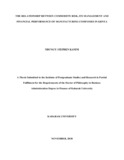The relationship between commodity risk, its management and financial performance of manufacturing companies in Kenya
Abstract
Commodity risk exposure and its management is critical for any business entity as the risk management tactics used impact on the financial performance of an entity. This study adopts a pragmatic approach as it sought to establish the relationship between revenue volatility and financial performance and equally the relationship between commodity risk management tactics such as pricing tactics, inventory management tactics and corporate diversification tactics as used by manufacturing entities in Kenya and the financial performance of these entities focusing on the earnings before interest and tax (EBIT) and return on assets (ROA). The objectives of this study focused on the relationship of the above revenue volatility, inventory management, commodities pricing and corporate diversification tactics and the financial performance of manufacturing entities in Kenya. The study has made contributions towards evaluating the current trends in risk management and make critical input towards policy formulation. The theories upon which the research has been grounded include prospect theory, theory of storage, theory of price determination and the modern portfolio theory. The researcher conducted a thorough literature review focusing on the key variables of the study. The literature reviewed provides different perspectives and aspects of commodity risk management tactics, impact on enterprise value and ultimately its effect on financial performance. From the literature reviewed, the researcher established a gap exists as no research has been done in Kenya specifically focusing on commodity risk management tactics and their impact on the financial performance of manufacturing companies in Kenya thereby justifying the importance of the study. The study adopted an analytical research design in order to get a better understanding of the relationship between the independent variables and the dependent variable. The target population consisted of five hundred and two manufacturing companies in Kenya from which a representative sample of two hundred and eighteen companies was selected through stratified and random sampling from the key sectors as classified by the Kenya Association of Manufacturers (KAM). The study used ten-year panel data given that this period was adequate for an objective analysis. Data was collected from archival financial statements to compute the key measures under the independent and dependent variables. Data analysis was done through a general linear model for panel data analysis and the results presented in a concise manner. From the descriptive statistics, the data is normally distributed across all variables of the study and thus it can be construed the results obtained from the data are accurate. There was significant correlation between the independent and dependent variables but no multicollinearity was observed. From the findings, the first three null hypotheses of the study were rejected implying that revenue volatility, inventory management, and commodity pricing variables have significant relationship with the financial performance of manufacturing entities in Kenya. For corporate diversification, the null hypothesis was not rejected implying that corporate diversification does not have a significant relationship with the financial performance of manufacturing companies. The researcher recommends that manufacturing entities should pay special attention to revenue volatility, inventory management and commodity pricing in order to enhance their financial performance.

